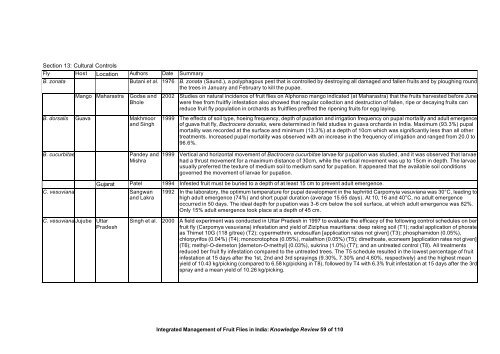“Key Informant Survey” of Production, Value, Losses and ... - DfID
“Key Informant Survey” of Production, Value, Losses and ... - DfID
“Key Informant Survey” of Production, Value, Losses and ... - DfID
Create successful ePaper yourself
Turn your PDF publications into a flip-book with our unique Google optimized e-Paper software.
Section 13: Cultural Controls<br />
Fly Host Location Authors Date Summary<br />
B. zonata Butani et al. 1976 B. zonata (Saund.), a polyphagous pest that is controlled by destroying all damaged <strong>and</strong> fallen fruits <strong>and</strong> by ploughing round<br />
the trees in January <strong>and</strong> February to kill the pupae.<br />
Mango Maharastra Godse <strong>and</strong><br />
Bhole<br />
B. dorsalis Guava Makhmoor<br />
<strong>and</strong> Singh<br />
B. cucurbitae P<strong>and</strong>ey <strong>and</strong><br />
Mishra<br />
2002 Studies on natural incidence <strong>of</strong> fruit flies on Alphonso mango indicated (at Maharastra) that the fruits harvested before June<br />
were free from fruitfly infestation also showed that regular collection <strong>and</strong> destruction <strong>of</strong> fallen, ripe or decaying fruits can<br />
reduce fruit fly population in orchards as fruitflies preffred the ripening fruits for egg laying.<br />
1999 The effects <strong>of</strong> soil type, hoeing frequency, depth <strong>of</strong> pupation <strong>and</strong> irrigation frequency on pupal mortality <strong>and</strong> adult emergence<br />
<strong>of</strong> guava fruit fly, Bactrocera dorsalis, were determined in field studies in guava orchards in India. Maximum (93.3%) pupal<br />
mortality was recorded at the surface <strong>and</strong> minimum (13.3%) at a depth <strong>of</strong> 10cm which was significantly less than all other<br />
treatments. Increased pupal mortality was observed with an increase in the frequency <strong>of</strong> irrigation <strong>and</strong> ranged from 20.0 to<br />
96.6%.<br />
1999 Vertical <strong>and</strong> horizontal movement <strong>of</strong> Bactrocera cucurbitae larvae for pupation was studied, <strong>and</strong> it was observed that larvae<br />
had a thrust movement for a maximum distance <strong>of</strong> 30cm, while the vertical movement was up to 15cm in depth. The larvae<br />
usually preferred the texture <strong>of</strong> medium soil to medium s<strong>and</strong> for pupation. It appeared that the available soil conditions<br />
governed the movement <strong>of</strong> larvae for pupation.<br />
Gujarat Patel 1994 Infested fruit must be buried to a depth <strong>of</strong> at least 15 cm to prevent adult emergence.<br />
C. vesuviana Sangwan<br />
<strong>and</strong> Lakra<br />
C. vesuviana Jujube Uttar<br />
Pradesh<br />
1992 In the laboratory, the optimum temperature for pupal development in the tephritid Carpomyia vesuviana was 30°C, leading to<br />
high adult emergence (74%) <strong>and</strong> short pupal duration (average 15.65 days). At 10, 16 <strong>and</strong> 40°C, no adult emergence<br />
occurred in 50 days. The ideal depth for pupation was 3-6 cm below the soil surface, at which adult emergence was 82%.<br />
Only 15% adult emergence took place at a depth <strong>of</strong> 45 cm.<br />
Singh et al. 2000 A field experiment was conducted in Uttar Pradesh in 1997 to evaluate the efficacy <strong>of</strong> the following control schedules on ber<br />
fruit fly (Carpomya vesuviana) infestation <strong>and</strong> yield <strong>of</strong> Ziziphus mauritiana: deep raking soil (T1); radial application <strong>of</strong> phorate<br />
as Thimet 10G (118 g/tree) (T2); cypermethrin, endosulfan [application rates not given] (T3); phosphamidon (0.05%),<br />
chlorpyrifos (0.04%) (T4); monocrotophos (0.05%), malathion (0.05%) (T5); dimethoate, econeem [application rates not given]<br />
(T6); methyl-O-demeton [demeton-O-methyl] (0.03%), sukrina (1.0%) (T7); <strong>and</strong> an untreated control (T8). All treatments<br />
reduced ber fruit fly infestation compared to the untreated trees. The T5 schedule resulted in the lowest percentage <strong>of</strong> fruit<br />
infestation at 15 days after the 1st, 2nd <strong>and</strong> 3rd sprayings (9.30%, 7.30% <strong>and</strong> 4.60%, respectively) <strong>and</strong> the highest mean<br />
yield <strong>of</strong> 10.43 kg/picking (compared to 6.58 kg/picking in T8), followed by T4 with 6.3% fruit infestation at 15 days after the 3rd<br />
spray <strong>and</strong> a mean yield <strong>of</strong> 10.26 kg/picking.<br />
Integrated Management <strong>of</strong> Fruit Flies in India: Knowledge Review 59 <strong>of</strong> 110

















